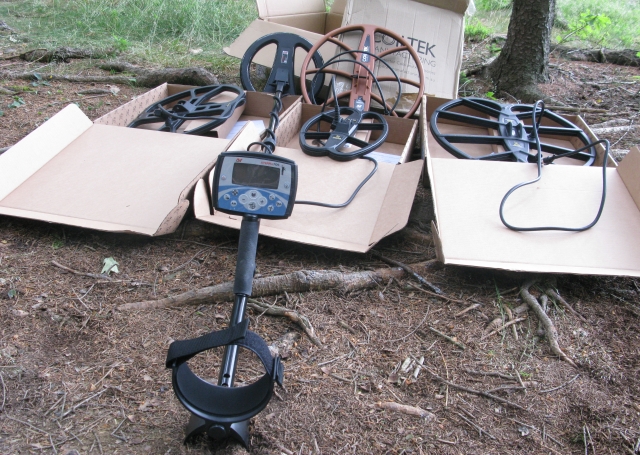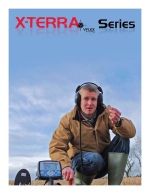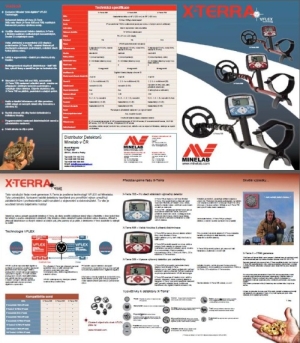Dobrá práce klucki.Ještě by mě zajímalo srovnání Minelab sond 7,5 kHz 26cm 2D a 18,75 kHz 26 cm 2D
X-Terra 705 metal detector, or real tests of additional probes and recommended settings
Categories: X-Terra series metal detectors , Testy cívek pro detektory kovů Minelab

The sun went down a bit and at least a few clouds appeared in the sky, so Dan and I finally got to test the long-planned X-Terra 705 with additional probes.
The X-Terra 705 is a detector that will get everyone by its technical processing. The possibility to use three working frequencies and the prospecting mode is quite exceptional at this price. In addition, there are additional types of probes that can be used with this detector and the choice is more than decent. We have tested the probes individually at various locations, but never together like this. I was quite excited to see what the differences would be between the different targets. On the new polygon there are now targets at depths from 15 cm to 50 cm, so you can test anything.
Detector settings
The X-Terra 705, despite the great possibilities it gives, has a very simple setup. However, you need to follow a few standard procedures.
Number oftones - according to your preference. If one digs every color, one can walk around in two-tone audio without a problem. But if you prefer the most accurate evaluation, multitone is the best choice
Threshold settings - as always, soyou can hear it. But I would see a minimum value of 6
Interference tuning- I would always recommend using auto mode before you start looking.
Sensitivity setting - leave the probe free 5cm above the ground in a place where there is no metal. Set the sensitivity to maximum and swing a few times. If the detector makes a clicking noise, lower the sensitivity one notch and repeat. Do not try to lower the sensitivity too much. There are many locations where you can walk around at settings 27 to 29 and it shows in the range!
Volume - bypreference . Without headphones probably always about max, always depends on ambient noise. But using headphones is definitely recommended.
Soil influence tuning
The Terra 705 offers a total of three options to get things done. The classic standard method is to press the detune button, use the minus button to go down to the lowest value and then slowly pump between 2 and 20 cm, adding a plus value and looking for the point where the detector goes silent. The second semi-automatic option is to press the detune button, start pumping and leave everything to the automatic (split crank/mince button). The result is very similar in most cases. The last option is to press the curve symbol on the control panel, which then appears on the LCD. In this mode, the detector continuously evaluates the mineralization. It is a mode suitable for locations where the values change very quickly. However, the price for this luxury is a slight loss in range.

Probe test
The detector was tested in the following settings: sensitivity 25, threshold 12, disk All Metal, audio Multitone, working channel 1, manual GB setting. We found Nel Hunter, Nel Storm, Coiltek WOT and Nel Big to be the most interesting additional probes from manufacturers other than Minelab. I will start with the description from the beginning, i.e. from the smallest one.
Nel Hunter at a working frequency of 18.75 kHz It could certainly be considered at first glance as a probe suitable primarily for separation or purely as an alternative to the basic probe that comes at 7 kHz. This probe was the biggest surprise of the test.
Results achievedwith the Nel Hunter 18 kHz probe
| Nel Hunter 18 kHz | 2h RU 15 cm | 2h RU 20 cm | 2h RU 25 cm | 1Kcs 20 cm | 1 Kčs 25 cm | 1 Kčs 30 cm | 1 Kčs 36cm | Buckle RU 50 cm | 3 Cu 40 cm |
| Strongly *** | Decent ** | Weak * | Strongly *** | Strong *** | Weak * | No response * | Weak * | No response * |
The result was better than we expected, especially considering that it is literally dry as hell. Additionally, the probe has very hilarious separation properties and I would personally rate it as the best I've seen so far for everyday searching.
Nel Storm at 18.75 kHz I have had the opportunity to see in action most often and I know what this probe can do. Even with the heavier weight, anyone can get a couple of hours with this coil. It should be ideal for tracking deeply buried targets over larger areas.
Results achieved with the Nel Storm 18 kHz probe
| Nel Storm 18 kHz | 2h RU 15 cm | 2h RU 20 cm | 2h RU 25 cm | 1Kcs 20 cm | 1 Kčs 25 cm | 1 Kčs 30cm |
1 Kčs 36 cm |
Buckle RU 50 cm | 3 Cu 40 cm |
| Strong *** | Strong *** | Weakly * | Strong *** | Strong *** | Fairly ** | Weakly, into the iron * | Weak * | Weak * |
The probe has shown what it can do and with basically the results we expected. This reel can only be recommended when you decide you want to give yourself a good dig.
The probe we tested, perhaps for the first time, was Coiltek's WOT 15"but at a lower operating frequency of 3 kHz. The probe is designed primarily for searching for deeply buried targets. I was surprised by the nice steady response to detected targets.
Results achieved with the Coiltek WOT 3 kHz probe
| Coiltek WOT 3 kHz | 2h RU 15 cm | 2h RU 20 cm | 2h RU 25 cm | 1Kčs 20 cm | 1 Kčs 25 cm | 1 Kčs 30 cm | 1 Kčs 36 cm | Buckle RU 50 cm | 3 Krejcars CU - 40 cm |
| Strong *** | Strong *** | Into the iron *** |
Strong *** | Strongly *** | Decent ** | Into the iron *** | Decent ** | Weakly * |
I think the probe is mainly for finding larger targets, but we liked it a lot. Moreover, it has literally excellent workmanship and of all the Coiltek coils I rate it the best in terms of workmanship!
The last probe I would like to point out is the Big from Nelu on 7 kHz. To be honest, apart from the big weight, we didn't expect much at the beginning.
Results achieved with the Nel Big 7 kHz probe
| Coiltek WOT 3 kHz | 2h RU 15 cm | 2h RU 20 cm | 2h RU 25 cm | 1 Kčs 20 cm | 1 Kčs 25 cm | 1 Kčs 30 cm | 1 Kčs 36 cm | Buckle RU 50 cm | 3 Cu 40 cm |
| Strongly *** | Decent ** | Decent ** |
Strongly *** | Decent ** | Decent ** | Weakly * | Decent ** | Weak * |
The problem with these giant probes is the large coverage. Because of this, even on a relatively clean polygon, it is easy for other targets to get under the probe, which then affects the response on both the LCD and audio. The response only stabilizes when you find the center of such a target and shorten the movement. Despite the weight of the probe and these problems, we were very pleasantly surprised that it did not put the targets in "iron".
There are a number of other complementary probes being made for the X-Terra series that have their pros and cons. In terms of versatility, however, we found these four to be the best, unless you ignore the probes made directly by Minelab, where the 26 cm 2D 18 kHz probe in particular is rightly very popular.
Just as we played around with range today, next week we'll torment the other probes on the X-Terry in separation tests. We'll post the results on LP then.
Video
In the video, you can see the new polygon setup as the Guardian and I captured it last week

Catalogues of the X-Terra series of metal detectors Minelab are freely downloadable in pdf format
 |
 |
The article is included in categories:
- Archive of articles > Metal Detectors - Reviews and Tests > Minelab – tests and reviews > X-Terra series metal detectors
- Archive of articles > Metal Detectors - Reviews and Tests > Minelab – tests and reviews > Testy cívek pro detektory kovů Minelab
Post
To kuba: Na testované cíle by sondy byly v podstatě stejné. Rozdíl se projeví u nejdrobnějších Ag, kde bude ta 18,75 kHz přesvědčivější 
jj mám Storm a můžu jen doporučit 
někde jsem četl, že když odladím automaticky a pak hodnotu která se mi ukáže na displeji ještě ponížím nebo zvýším(teď nevím) ručně o cca pět dílků tak se zvýší dosah detektoru? 
To sphagi: GB lehce do mínusu přinese lehce zvýčený dosah a to především v půdách s mírnou mineralizací. Chce to nepřehánět, jinak je tam nárůst prozvuků 
a co se stane když se posune do plusu? díky za upřesnění 
Dosah jde spíše dolu 
aha takže opak...selský rozum mi to říkal, ale nedalo mi to se neoptat 
náhodou - jak by test dopad, kdyby na něj šla gm4 se 30 spiderkou? 
To asgardus: velice dobře, přijeeď si to otestovat 
Nemůžu si pomoct, ale vidm dobře cca v čase 0:16 houbu? 
GM4: tak to fakt nevím, jestli ano, tak jsme se Strážcem úplně slepí 
To tibko:na polygon chodí všichni kdo k nám jednou testovat detektory, tudíž už tam pár hledačů bylo. Párkrát už zapršelo a tak je to už jako docela jako beton. Taky jsme tam děli testy až s týdením odstupem, jinak to nemá moc smysl a nevýš vlastně co by jsi kopal a co ne 
X-TERRA je velmi zajimavý detektor, stačí si vzít lepší cívku a člověk žasne co umí, osobně odzkoušeno 
definuj " lepší cívku" osobně odzkoušeno - tak ktora to je
to Elmara: proč v testu není srovnání se standardně dodávanou sondou Minelab 10" DD 7.5kHz? Sorry, ale takhle mi to přijde docela zkreslený, když nejsou informace, jak by se na ty vaše cíle za stejných půdních podmínek choval origoš Minelab. Ale možná to je účelem... 
To Tomisek: Jakej účel?? Každý x-terrák ví co základní sonda na 705ce dokáže  Mě osobně se nejvíc při testu líbil ten Hunter od Nelu na 18kHz..
Mě osobně se nejvíc při testu líbil ten Hunter od Nelu na 18kHz..
To tomísek: není problém udělat testy další. Sonda nechodí špatně, ale je to základ a byla prostě o něco slabší. Navíc testy té sondy už jsme dělali. Myslel jsem, že to už dávno každý četl. U těch větších sond navíc můsíš vždy počítat s tím že ta velikost prostě ubere zase na separačních vlastnostech. To obvinění s účelnosti..... Najdi si v archivu všechny naše testy 705 
to habán: Jojo, Xterru jsem měl 70 i 705, takže vím co umí. 
to Elmara: vím, kdysi se něco testovalo s mincema. Myslel jsem, že když je nový polygon, provést nějaký test i se standardní cívkou. Bylo by mnohem víc vypovídající co ty doplňkové cívky umí, nemyslíš?
PS: nebylo by taky dobré testovat i něco jiného než jednotlivé mince v různých hloubkách? Nějaké větší přeměty - džbáneček s mincema, bronzová sekyra apod.... 
To tomísek: problém je, že když dáš do polygonu cíle, které se nedají lehce opakovat, těžko si pak výsledky může někdo sám doma otestovat, když si detektor koupí a chce vědět zda to co prodejce tvrdí byla taky pravda. Proto ty testy děláme v podstatě vždy jenom na mince, které má každý hledač. Na starém polygonu máme například zakopaný v 1,1 metru 15 litrový kanystr a v 90 cm velký lybar. To si ale nikdo ověřit nemůže, navíc si myslím že výsledek na takové cíle už neznalost detektoru nebo momentální strav půdy ovlivňuje natolik že je to vždy spekulativní tvrzení.
Při testech ale Nelka Big oba cíle vzala a cca před půl hodinou jsem tam byl s jedním pánem právě tuhle sondu testovat a oba cíle jsme znovu brali. Trochu ale občas sprchlo, pokud by byla půda úplně vyschlá, byl by to už problém. To ale určitě znáš. 
ach jo, Elmaro, řekni aspoň, jestli by ta gm4 cíle kopatelně brala, pěkně prosím! 
To asgardus: zaleží s jakou sondou  Ne po dovolené budeme dělat velký test všech GM a ZERO. Navíc to i zveřejníme na LP aby každý kdo bude chtít mohl přijet a otestovat si sám.
Ne po dovolené budeme dělat velký test všech GM a ZERO. Navíc to i zveřejníme na LP aby každý kdo bude chtít mohl přijet a otestovat si sám. 
Elmara: to by bylo úžasný  už se těšim, až budete mít po dovolený! kdy asi?
už se těšim, až budete mít po dovolený! kdy asi?  omlouvám se za zvědavost
omlouvám se za zvědavost
Je se chystam koupit Nel Hunter na moji 305ku poradi mi nekdo jestli brat 18.75kHz nebo 7.5kHz?Zatim mam 26cm 2D 18 kHz a chci ziskat predevsim hloubku.
To asgardus: test bude v rámci týdnes Golden Mask. Bude toho více. Předpokládaný termín je na přelomu července a srpna.
amates: jednoznačně bych volil 18,75 kHz, jak jsme napsal v teestu, pro mě nejpříjemnější překvapení testu 
Me jde predevsim o dosah protoze 305ka oproti 705ce ho ma o dost mensi(odzkouseno).Nemela by civka na nizsi frekvenci mit vyssi dosah?
To smates:záleží na jak velké předměty a v jakém prostředí. na drobné mince určitě ne, tam je 18 kHz vhodnější. 
Zdravím, nějak nejsem spokojnej s Nel Storm 18 kHz, dosah je mizernej... zkoušel jsem venku /zlatnik do max cca 10cm/ air test doma max 20cm
zhlednul jsem různé testy a tá moje je fakt mizerná...

















